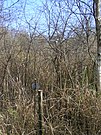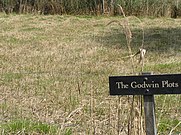Sweet peas

Wicken Fen is a nature reserve near the village of Wicken between Cambridge and Ely in Cambridgeshire , England .
reserve
The reserve consists of fenland , marshland , reed beds and farmland . Wicken Fen is one of only four feral fens in East Anglia , where otherwise 99.9% of the previous fens have been converted to farmland. It is designated as a Site of Special Scientific Interest .
history
Wicken Fen is one of the UK's oldest nature reserves and was the first National Trust- managed nature reserve in 1899 . The first parcel was donated to the National Trust in 1901 by Charles Rothschild .
management
Wicken Fen gives an insight into nature as it has looked in this area since the Middle Ages. In terms of nature conservation, the reserve is intensively protected and cared for in order to preserve the unusual species that have developed there over centuries. For example, the reed of the cane edge has been harvested annually for roofing since 1414. This created a habitat for plants and animals that are dependent on this cycle. In some areas, Konik ponies and Scottish highland cattle graze today to keep the vegetation short.
science
Wicken Fen has long been researched by natural scientists. Renowned Victorian entomologists collected beetles, moths, and butterflies there, and some of them are still on display in museums today. Since the 1920s, botanists Sir Arthur Tansley and Sir Harry Godwin pioneered the preservation of the reserve. A long-term experiment to observe the vegetation of fallow land, the so-called Godwin Plots , began in the 1920s by Harry Godwin and is still being carried out today.
accessibility
Wicken Fen is open to the public. The site is accessible from sunrise to sunset all year round, with the exception of Christmas Day . Some trails will be closed in bad weather and some areas will be inaccessible. There is a jetty made from recycled plastic to two bird watching huts, which are always open. There is a visitor center with a shop, toilets and a café. Fen Cottage is open on Sundays and shows the life of the Fenland people in the early 20th century.
The trails in and around Wicken Fen were shown on Google Street View long before most of the UK's urban areas.
Development of the reserve
On May 1, 1899, the National Trust bought two acres (8,094 m 2 ) for £ 10. The National Trust bought land there for over a century as soon as it became available. By 1951, 247 hectares (611 acres) of the Fens were already categorized as the Site of Special Scientific Importance . The Fen was recorded by the Nature Conservation Review in 1977 and is a National Nature Reserve and Ramsar wetland of international importance. The National Trust already owned 2,300 acres of the vetch fen in 2001.
vision
The National Trust has been planning to expand the Wicken Fen to 56 km² (22 square miles) over the next 100 years by purchasing land at market prices since 1999. In 2001, a large piece of land was acquired with the Burwell Fen Farm (1.65 km 2 ). In 2005 the 100 hectare peat farm on Tubney Fen was acquired. Other acquisitions include 2009 Hurdle Hall Farm and Oily Hall Farm and 2011 St. Edmunds Fen.
Lodes Way
Starting in 2008, the National Trust, together with Sustrans Wicken Fen, connected Anglesey Abbey and Bottisham with over 14 km (9 miles) of paths and bridges for pedestrians, cyclists and horse riders. The total cost of this was £ 2m, of which £ 600,000 was raised through Sustrans' Connect2 project.
Flora and fauna
Nature lovers were enthusiastic about the Wicken Fen from the start because it offered a great variety of species. Very unusual species can also be found there. In 1998 over twenty previously unknown species were found in the Fen and in 2005 another ten. The species are listed in lists that are available on the Internet. Many species of flies, snails, spiders and beetles live in the reserve.
plants
Notable plants include the ditch violet and the rush edge .
Birds

The birds of the vetch fen are easier to spot than many insects for most visitors.
literature
- LE Friday (Ed.): Wicken Fen: the making of a wetland nature reserve . Harley Books, Colchester 1997.
- LE Friday, B. Harley: Checklist of the Flora and Fauna of Wicken Fen . Harley Books, Colchester 2000.
Individual evidence
- ↑ a b Wicken Fen National Nature Reserve . Sweet peas Archived from the original on February 18, 2009.
- ↑ Tim Sands: Wildlife in Trust: a hundred years of nature conservation . The Wildlife Trusts, 2012, p. 672.
- ^ Research . Sweet peas Archived from the original on May 28, 2013.
- ↑ Maps of National Trust owned land at Wicken Fen ( memento of the original from November 19, 2011 in the Internet Archive ) Info: The archive link has been inserted automatically and has not yet been checked. Please check the original and archive link according to the instructions and then remove this notice. , accessed December 18, 2011
- ^ SSSI Citation
- ^ Natural England NNR web page
- ^ Ramsar List
- ↑ a b c The Wicken Vision - Introduction . National Trust . Archived from the original on May 25, 2012. Retrieved December 30, 2011.
- ↑ National Trust Annual Reports ( Memento of the original dated December 26, 2011 in the Internet Archive ) Info: The archive link was inserted automatically and has not yet been checked. Please check the original and archive link according to the instructions and then remove this notice.
- ↑ Vision Bridges the Gap . National Trust. April 18, 2010. Archived from the original on July 18, 2011. Retrieved on December 30, 2011.
- ↑ The Wicken Vision - Lodes Way . National Trust . Archived from the original on November 5, 2012. Retrieved December 30, 2011.
- ↑ Cambridge to Wicken Fen walking and cycling network - now a step closer . Sustrans . March 4, 2009. Accessed on July 14, 2009. ( Page no longer available , search in web archives ) Info: The link was automatically marked as defective. Please check the link according to the instructions and then remove this notice.
- ↑ a b c Wildlife . Sweet peas Archived from the original on December 29, 2010.
- ↑ National Trust Annual Report, 2009 ( Memento of the original dated June 29, 2011 in the Internet Archive ) Info: The archive link was inserted automatically and has not yet been checked. Please check the original and archive link according to the instructions and then remove this notice. .
Coordinates: 52 ° 18 ′ 38.9 ″ N , 0 ° 17 ′ 28.8 ″ E






